Suzuki might be the smallest of the big four Japanese bike firms. And it’s been a bit quiet in terms of new bikes in recent years. But it’s made some brilliant machines over the years, and plenty of them are still crackers, with loads of ‘future classic’ collectable models too.
We’ve picked out our favourites from the 21st century – so far. Ranging from the small-but-perfectly-formed DR-Z400 SM supermoto, to the mighty GSX1300R Hayabusa, with lots of saucy metal in between, there’s something here for everyone.
Sadly, they’re all a few years old now – but Suzuki reckons it’s got some cracking new bikes up its sleeve for next year (2023) and beyond. Here’s hoping for a rather different top ten in a few years’ time…
GSX-R750
One of the most legendary names in biking: the original GSX-R750 of 1985 was the first ‘proper’ race replica. Its oil-cooled 749cc DOHC 16v engine made a claimed 100bhp: a lot back then, and a match for the bigger, heavier, water-cooled Kawasaki GPZ900R launched the year before. The chassis was the big story though: a cradle-type aluminium frame with stiff square-section tubes and track-ready suspension, brakes and wheels. It was light too, at just 176kg dry, and kicked off the 750cc superbike revolution.
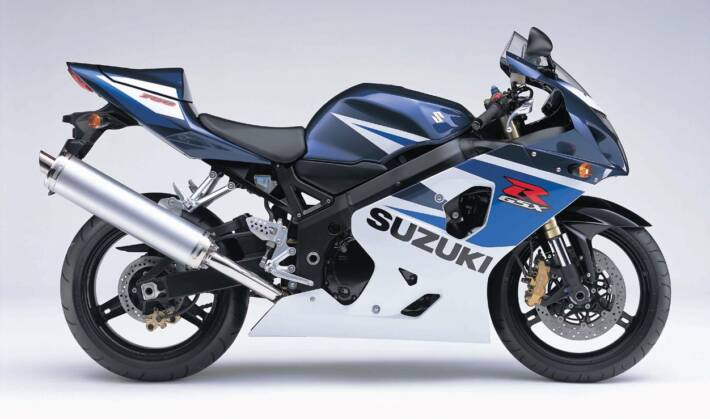
The first F model is a collector’s item now, and well worth a look if you fancy a restoration project. But our pick for a more modern ride is the last of the water-cooled models, which went off sale in 2018 in the UK and Europe, scuppered by Euro 4 emissions regs.
It’s a basic machine in many ways, with no ABS or traction control, ride-by-wire throttle or even a modern ABS setup. But it makes nearly 150bhp, weighs in at just 190kg dry, and has superb handling even as standard. With some suspension fettling, race rubber and a mild engine tune, it’s the perfect trackday machine, and ideal for intermediate track riders looking for a step up from a 600cc machine.
The lack of electronics is an advantage to some – less to go wrong, and a ‘purer’ riding experience. And if you’re really looking to develop your skills on track, the lack of rider aids arguably gives a ‘purer’ learning experience.
GSX-R1000
It’s fitting that Suzuki came in with a bang at the start of the 1000cc superbike era. It had ruled the roost with the GSX-R750 in 1985, and 16 years later, it brought out the K1 version of the GSX-R1000, just in time for the move away from 750cc fours in superbike racing.
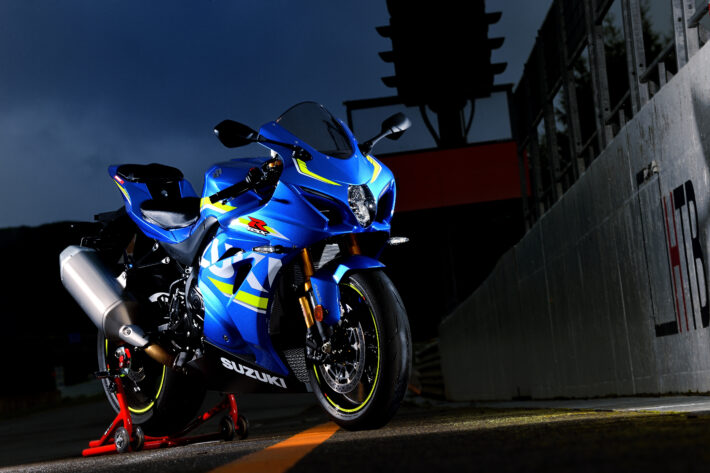
There was nothing of the previous big-bore GSX-R (the water-cooled GSX-R1100) in this design at all – rather it was an expanded variant of the 2000 GSX-R750 SRAD. Its 988cc capacity came from a long-stroke redesign of the 750 motor, with a slightly bigger bore and it made a heady 160bhp, weighing in at 170kg dry – numbers which just topped Yamaha’s R1, at the time the class leader.
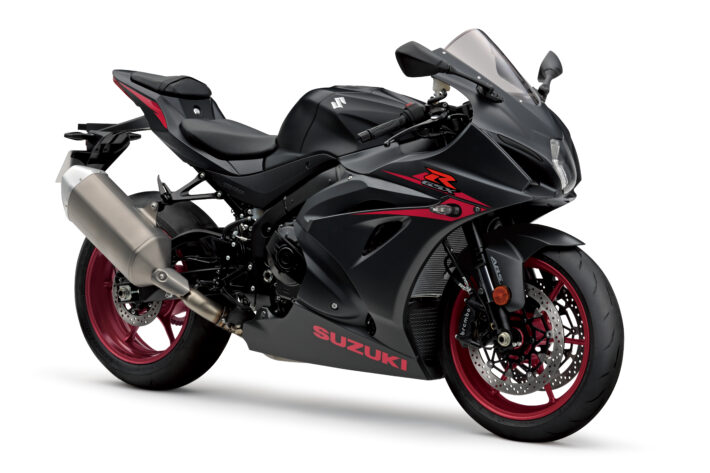
The Gixxer 1000 evolved through another minor update in 2003 before a full-on revamp for the 2005 K5 variant. This is probably the best of the bunch, and was a revelation when launched with 178bhp and more grunt from a full 999cc engine redesign. The handling was stupendous too, and it weighed in at just 166kg dry.
The latest GSX-R1000 launched in 2017, and was a big step up, with 200bhp, full electronics package and cunning mechanical variable valve timing. It had a sweet chassis setup too, and the ‘R” version added Showa gas forks and a standard quickshifter for a bit more cash.
GSX1300R Hayabusa
In many ways the most evocative Suzuki, the Hayabusa rocked the world when it appeared in 1999. At the time, the ‘hyperbike’ or unlimited supersports-tourer class was red hot: Kawasaki’s ZZ-R1100 had kicked things off in 1990, then Honda had a nibble in 1996 with the Blackbird, which topped the ZZ-R on performance.
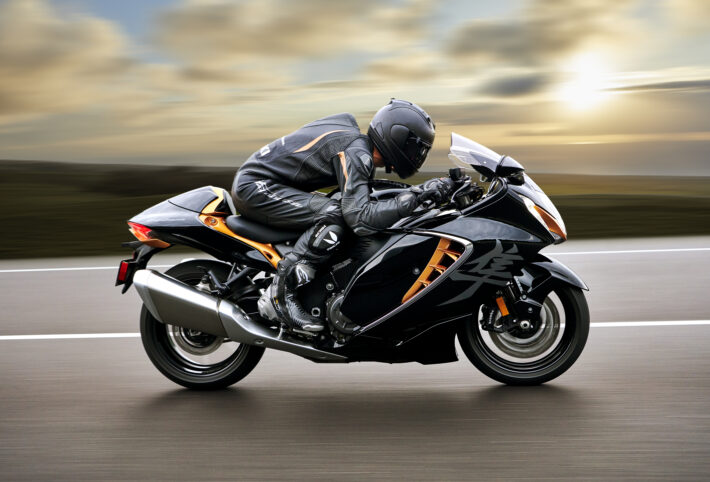
But the Hayabusa (named after the Japanese peregrine falcon) was in another league. Based on the design foundations of the GSX-R750, Suzuki added more capacity to make a 174bhp motor in a sporty chassis with super-slick bodywork on top. It approached 200mph in a straight line, but could also be hustled around a race track, and was comfy enough for long-distance two-up touring.
An all-rounder, which also happened to be the fastest bike you could buy? That was an easy route to sales success in the late 1990s and early 2000s for sure.
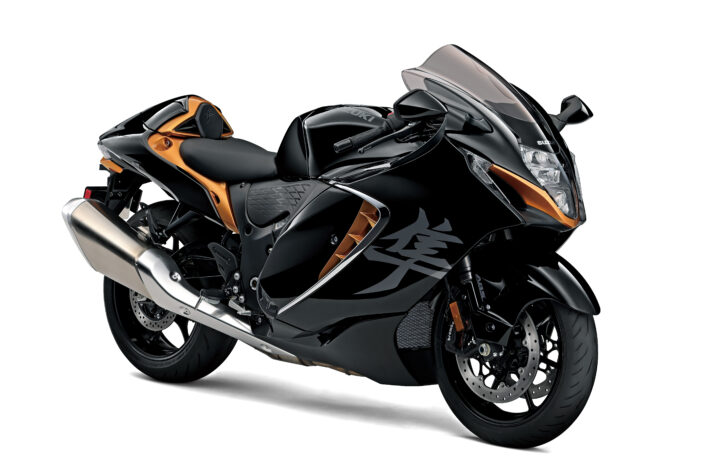
There have been two more generations of Hayabusa since, which added more capacity, up from 1,299cc to 1,340cc, and lots more tech. The current model is also festooned with electronics, boasting six power modes, cornering traction control, IMU-assisted ABS, hill start, engine brake control, wheelie control, quickshifter and cruise control, accessed via a full colour LCD dash. Power and mass remain much the same though, and it’s still a low, long, heavy, high-speed blaster.
Bandit 1200
The grand-daddy of the modern super-naked, Suzuki’s Bandit 1200 must be one of the most profitable bikes ever made. Because when first launched, it was a so-called ‘parts bin special’, which is to say most of the components were filched from existing bikes in the range.
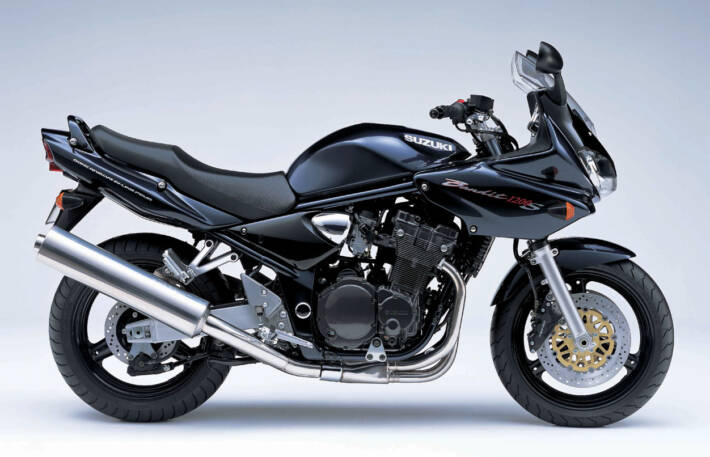
The 1,157cc engine was based on the old oil/air-cooled GSX-R1100 unit, with a 1mm big-bore and a tune aimed at more mid-range grunt than peak power. This strong, under-stressed motor, making around 97bhp, was bolted into a simple steel tube frame, with an aluminium box-section monoshock rear swingarm and conventional forks and brakes.
It echoed the Bandit 600 launched a year earlier, and came as a naked base version or a half-faired ‘S” variant. The naked bike was prettier and a few kg lighter at 211kg, but the ‘S’ was of course much more useful on longer runs.
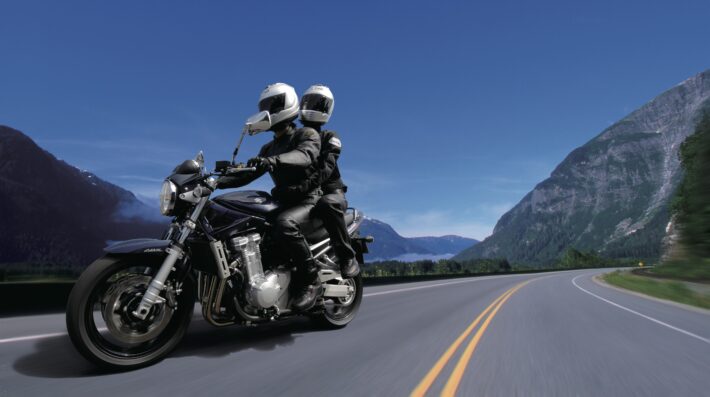
The Bandit’s ace card was its customisability. The basic bike was strong and simple, but there was scope for big improvements from easy mods. An exhaust and carburettor tune would produce 110bhp, with camshafts and larger carbs adding even more. The hardcore went for big-bore blocks, turbochargers and tougher internals, allowing double the base power and more.
For most people though, the Bandit 12 was just a good, solid bike, that had enough performance for a lot of fun, didn’t cost the Earth, and lasted well. Sold from 1996 till it was replaced by the water-cooled 1250 Bandit in 2007, it’s one of the truly great Suzuki motorcycles.
V-Strom 650
Back in 2004 when the V-Strom 650 first appeared, the adventure touring sector was far less important than it is now. So it wasn’t an immediate hit, despite its clear strengths. Based heavily on the hugely popular SV650, the DL650 V-Strom used the same V-twin engine and aluminium frame, with longer-travel suspension, a more upright riding position and styling borrowed from the firm’s Paris-Dakar rally bikes, though in a much softer form.
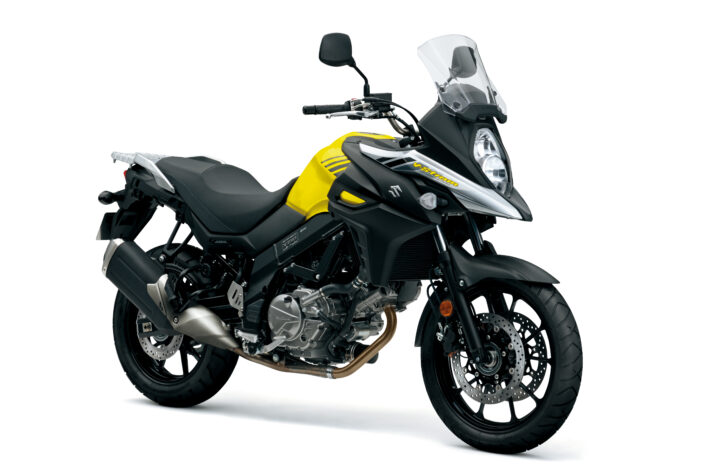
Like many ‘adventure’ machines, the original V-Strom wasn’t aimed at proper offroad work. Rather, it was a middleweight tourer, with dirt styling, larger 19” front wheel and extended suspension. The wheels are cast not wire spoked, the front mudguard is a close-fitting design which would quickly clog with mud, and the engine is completely exposed without a sump guard of any sort.
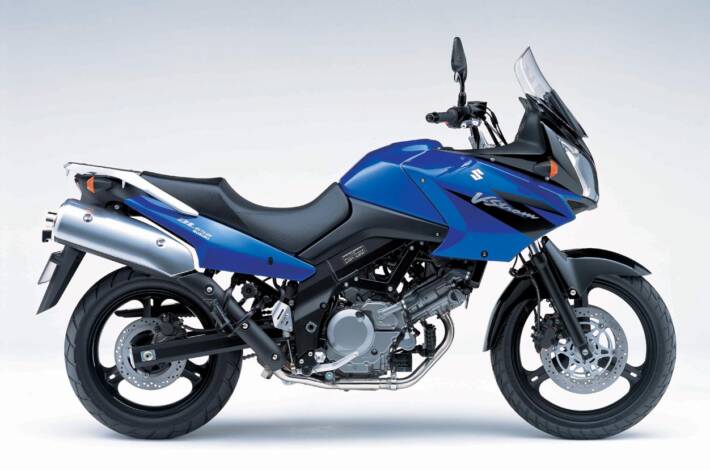
The DL650 was a cracking bike though. The slightly retuned engine made 66bhp, the riding position was comfy and commanding, and it was just so practical as a daily ride and all-rounder.
Over the 18 years since launch, the basics have remained much the same, but the details have changed. ABS appeared, the V-twin 645cc engine gained a Euro5 emissions tune with dual spark heads, and the styling took on much more of a hard-core edge. The current line-up offers a base bike and an XT dirt-focused version, which has wire-spoked rims, sump guard and hand protectors.
SV650
At the turn of the century, Suzuki had no less than FOUR separate middleweight 600-class engine platforms. There was the inline-four Bandit 600 roadsters and GSX-R600 supersport, the parallel-twin Burgman 650 scooter and this, the V-twin SV650 (there’s actually five if you add the Freewind single-cylinder trailie). Why so many? Who knows! But the V-twin fashion was well under way, and the SV arguably offered a lighter, sportier, more modern take on the roadster theme than the Bandit.
Initially carburetted, the SV650 soon gained fuel injection, and made for a solid, reliable, sporty middleweight, with both half-faired and naked versions to suit your needs. The small fairing and low bars added some sportiness and practicality for distance work, while the naked bike had a more upright stance for urban work and was a few kilos lighter.
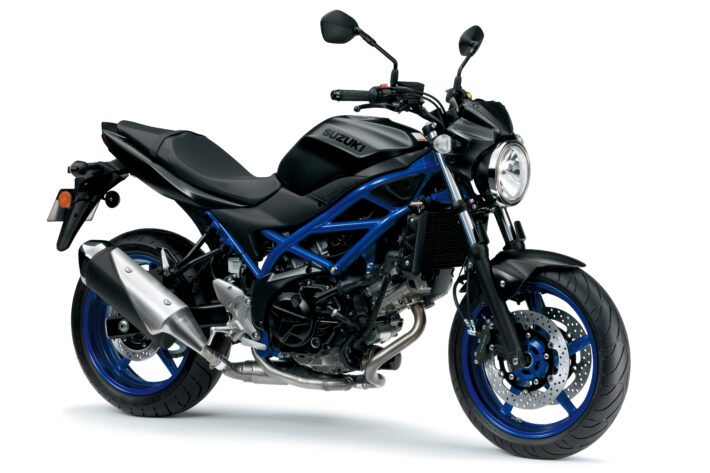
Never as fast as the four-cylinder competition like the Honda Hornet or Yamaha Fazer, it nevertheless gained a cult following amongst those keen on its plucky 70bhp engine and nimble 170kg chassis. It’s found a surprising second life in racing too, where it’s eligible for (and does well in) the popular Minitwins and Supertwins classes.
More than two decades after its launch, the SV650 is still on sale too, with an updated dual-spark Euro-5 version of the venerable 645cc motor providing the 72bhp peak power and a tweaked naked roadster chassis.
TL1000 R
In the late 1990s, the Japanese firms had been caught out completely by the Italian race bikes. First Ducati, then Aprilia, were building stonkng litre-class V-twin superbikes, with Ducati sweeping the decks in WSB against the 750cc fours. Honda and Suzuki responded with their own big twins, with varying levels of success. Suzuki’s new engine appeared first in the flawed half-faired TL1000 S in 1997, then in this full-faired race-replica variant, the TL1000 R for 1998.
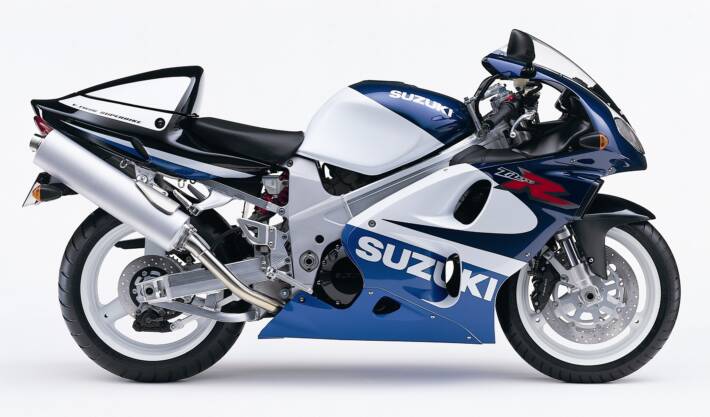
The R used a GSX-R750-style aluminium twin-spar frame, with top-end suspension and brakes – though it also stuck with the infamous rotary rear damper unit pioneered on the ‘S’ model. The 996cc engine was strong for its day, making 135bhp at the top end, but it had lost a bit of midrange as a result, making it less exciting than the TL-S. It was heavy too, at 190kg dry, and enjoyed little in terms of race success.
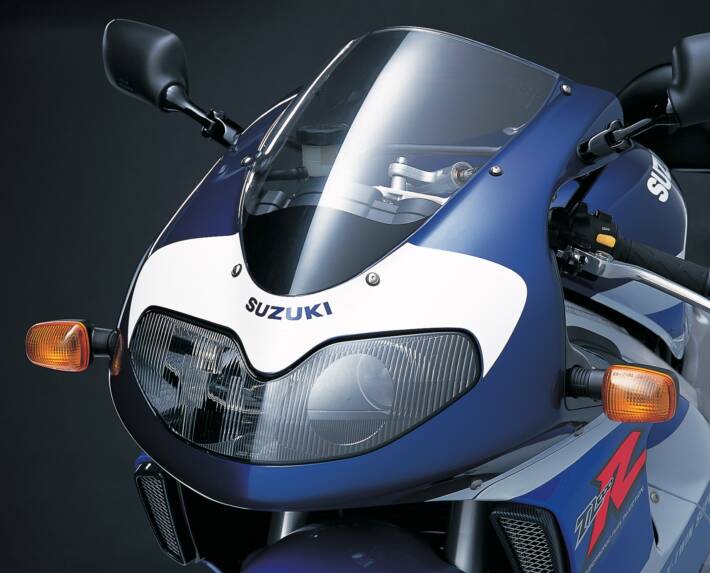
The TL1000 engine long outlived both the S and R, appearing in Cagiva’s Raptor 1000 and Bimota SB8R, where it actually won a WSBK race under Anthony Gobert. Suzuki has also got plenty of use from it: it’s powered the SV1000 and V-Strom models down the years, and is still used on the big V-Strom even now.
Today, the TL1000 R is a bit of an oddity. The mad reputation of the TL-S makes it more of a legend, with the R missing out a bit in comparison. As a result, you can pick one up for not a lot of cash, and it makes for a cool, unusual, retro superbike.
Burgman 650
The maxi-scooter genre is widely ignored in the UK – but that’s a maxi-mistake we reckon. If you think of them simply as automatic touring bikes, which just happen to have step-through frames, they make enormous sense. The Burgman 650 is, in spec terms, a high-tech Suzuki tourer: fuel injected parallel twin engine, with ABS, electric windscreen and mirrors, sport mode, heated grips and seat, digital dash, and loads of luggage space.
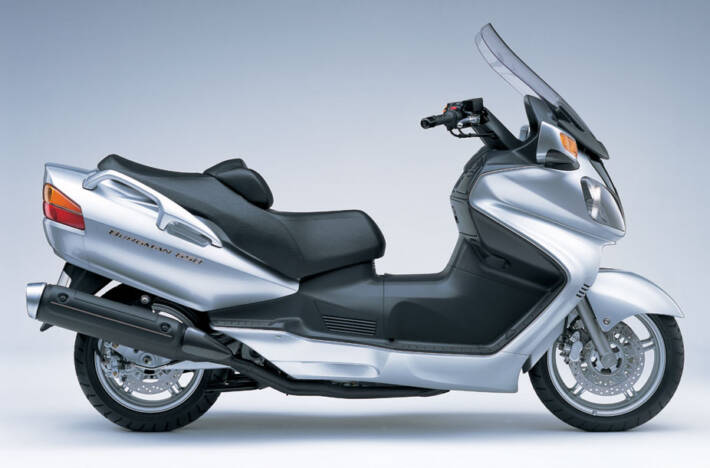
It just happens to be a scooter… It will hit 120mph, is super-comfy and insanely practical, with superb weather protection. Add a top box to the underseat storage, and you have enough space for a proper trip away.
The automatic transmission and final drive is largely maintenance-free, and has both full auto and manual modes. The power mode holds onto the revs till the redline in automatic mode, giving maximum acceleration for a sportier riding experience.
On the road, the Burgman 650 is a little bit big for really tight urban work (though the electric folding mirrors help a lot). As a suburban commuter, though, it’s hard to beat. It’s not as sporty as the Yamaha T-Max, but larger, comfier, more protective in terms of wind and weather, and has more underseat storage.
DR-Z400 SM
The smallest, lightest, and least powerful of all our fave Suzukis, but the little DR-Z, launched in 2000, is still a cracking machine. Based on a dirtbike design, its single-cylinder motor is water-cooled, with a DOHC four-valve head, 398cc capacity, and a carburettor rather than fuel injection. Output is a modest 40bhp, which sounds meagre, but this is a light 133kg machine, and doesn’t need hundreds of horses to provide the laughs.
The DR-Z was originally a dirt bike, sold in enduro trim, but this later SM version comes with 17” road wheels and tyres, with a larger front brake disc. The aim was to build a sharp urban machine, with supermoto styling and Tarmac-friendly handling. It’s a basic machine in many ways thanks to those dirt roots: the dash is spartan, and there’s little in the way of long distance comfort. The fuel tank holds barely more than two gallons as well – so it’s not a bike for motorway trips, obviously.
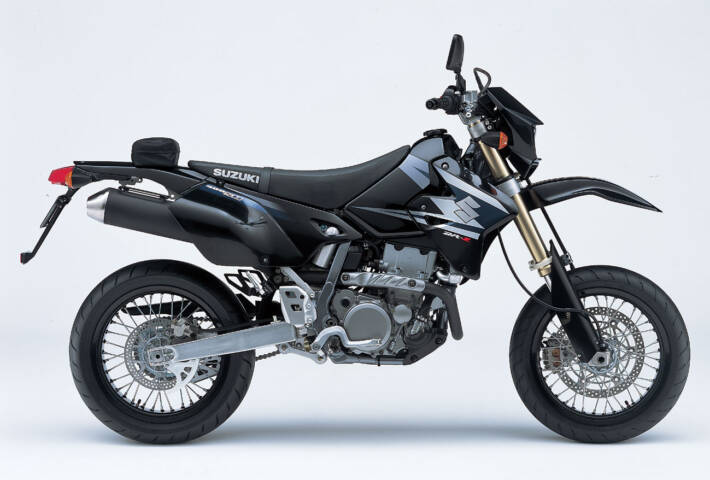
Keep the DR-Z400SM in town, or on twisty country back roads though, and it’s a belting little machine. Uprated tyres, sharper brake pads and perhaps some suspension tuning, and there’s not much that would match a well-ridden DR-Z400 in its natural urban environments. It’s also a fab little bike for learning stunts on: wheelie practice (on private ground…) with a DR-Z is spectacular fun.
GSX1400
This one makes us sad. The Suzuki GSX1400 is one of those bikes that takes us back to the early 2000s, when big, beefy muscle machines like this roamed the Earth. Alongside the Yamaha XJR1300 and Kawasaki ZRX1200, they looked great, had stacks of grunt, and were huge fun to ride.
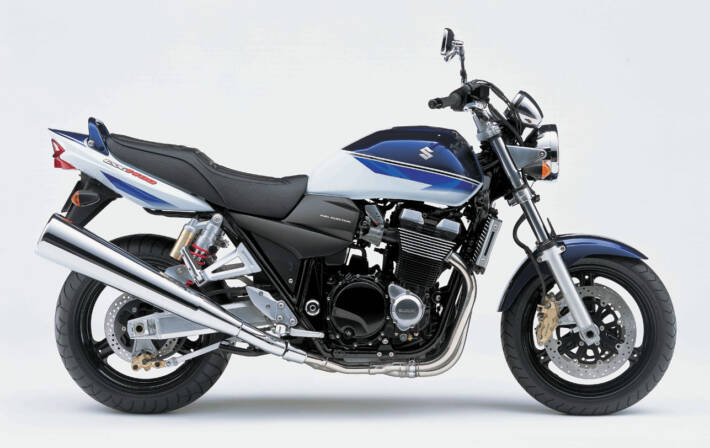
The GSX was a one-off though. Rather than take an existing motor, like the 1200 Bandit or one of the firm’s GSX-R lumps, the GSX1400 engine is unique, and didn’t appear anywhere else. It was a massive inline-four, with DOHC heads and 16 valves, and stuck with air and oil cooling rather than using water. It was pretty high-tech as well, using the same dual throttle valve fuel injection as the firm’s top-end superbikes.
With sculpted covers, smooth fins and premium black/polished finish, it dominated the looks of the bike at a standstill – and dominated the performance on the move. It was an unashamed torque monster, with tremendous low-down urge, and a super-flat torque curve hitting 93 foot-pounds at just 5,000rpm.
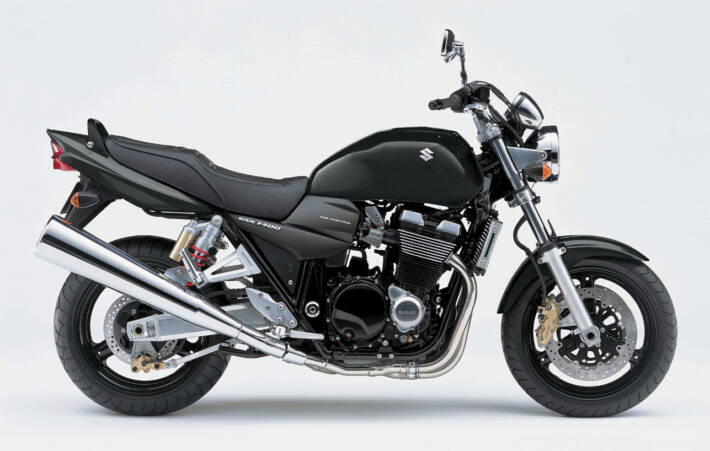
Peak power wasn’t outrageous for the 208kg dry weight, at around 105bhp, but enough for a naked muscle bike at the time, when the experience was more tilted towards cruising. Nowadays, big super-nakeds tend to have sportsbike-like performance, but 2001 was a simpler time. The big 1400 was a little short on ground clearance for track antics, and the suspension was more about comfort than speed.
But it had fully adjustable forks and rear shocks, and the six-piston Tokico brake calipers seen on the early GSX-R1000, Hayabusa and other high-end machinery.
The final part of the recipe is the styling. The GSX1400 is a cracking looking bike, with the lines of the tank, seat and tail unit flowing perfectly, premium finishes on all the metal work, and the gorgeous GSX-R-alike blue and white paint option.
4 comments on “Top Ten Suzuki Motorcycles”
yes great bikes mine the suzuki gsxr1000 is great rock solid easy to ride no probs
Where is the Van Van, super little bike 😎
No RG or RGV scandalous! 😲😠
Gs750, 850, 1000?